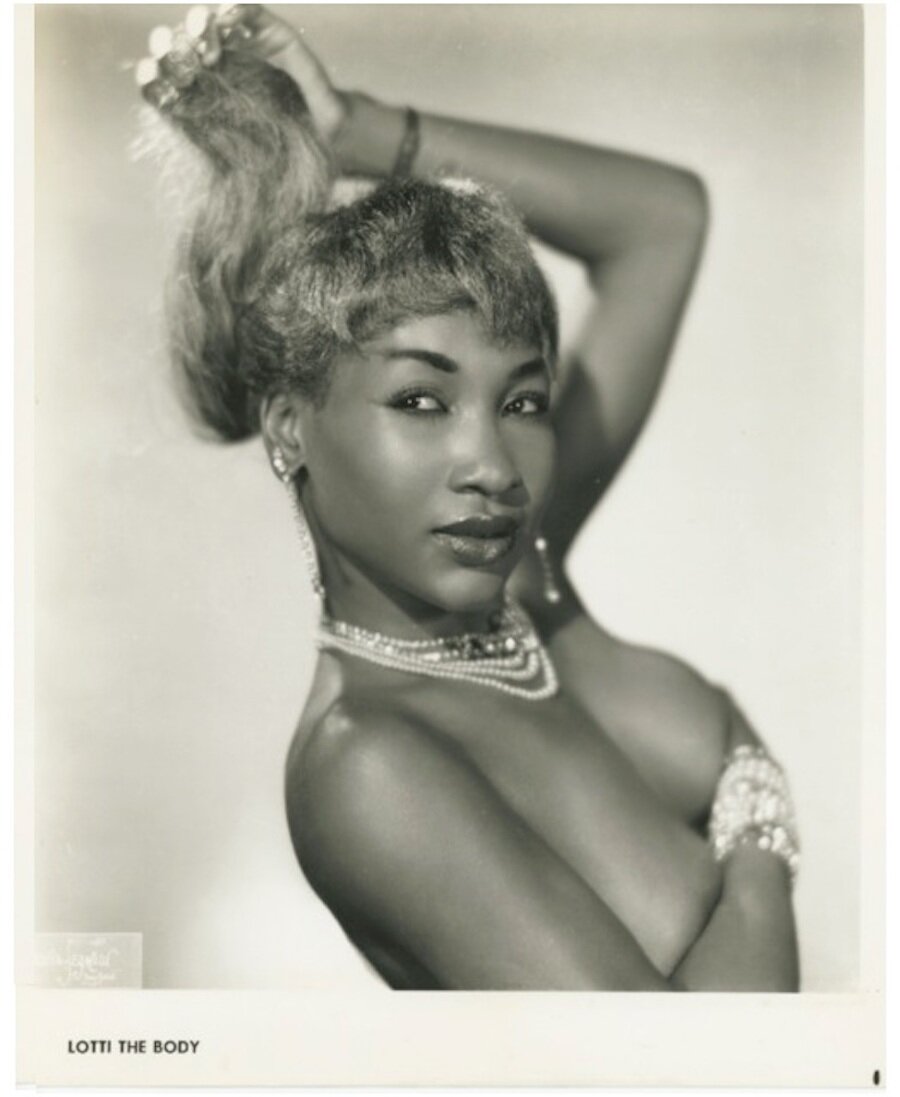Words by Roxy Bourdillon
In the latest Trailblazers of Tease, we remember the Black burlesque queen who followed her dreams, lived her own “Civil Rights Movement” and danced her way to stardom.
A burlesque goddess steps out from behind a velvet curtain. She poses seductively in the spotlight, looking utterly dazzling in her beaded gown, with her platinum hair sculpted into an elaborate updo. The band is playing a sultry number and she performs her striptease with unrivalled elegance. The crowd is mesmerised and who can blame them? This is, after all, Lottie The Body, “built like a double order of pancakes – sweet and stacked”.
She may have been famous for that spectacular figure, but the more you find out about her, the clearer it becomes: Lottie The Body was all heart and soul.
As you can probably tell by now, Fannie Annie was a force of nature.
Born Lottie Bristow in 1930, she grew up in Syracuse, New York. She took ballet lessons as a young girl and fell in love with pliés, pirouettes and the thrill of performing. Dancing was her passion and her superpower. By the time she was 17, she was doing it professionally in New York City. Her first gig was with Whitey’s Lindy Hoppers, but when the troupe dissolved, she had to figure out her next move. As a Black dancer living during racial segregation, opportunities were few and far between. In her chapter of What We Talk About When We’re Over 60, Lottie explains,
“There was only one place for me to dance, only one place for a professionally-trained Black dancer to make a living. Burlesque. It was either take off my clothes while dancing or don’t dance at all.” So, what did Lottie do? “I took it off.”
Studying with choreographer Katherine Dunham, who also worked with legendary songstress Eartha Kitt, Lottie became skilled in dance styles from Africa, the Caribbean and Latin America. She incorporated many of these moves into her burlesque routines, which were often set to Afro-Cuban music. When she relocated to Detroit, she immersed herself in the vibrant live arts scene. Lottie was hailed as the “Gypsy Rose Lee of Detroit” and the “Black Gypsy Rose Lee”, and audiences of all races flocked to see her enchanting act.
A total trailblazer, Lottie managed to carve a successful career during the height of segregation. She performed at all kinds of venues, including “white-only” nightclubs.
“In a day and age when African Americans were still not always welcome, I lived my own sort of Civil Rights Movement, making friends and connections in my own way wherever I went.”
One of her favourite gigs was Thursdays at Michigan’s Golden Horseshoe. It was the weekly night off for local domestic staff, most of whom were people of colour, and they all headed out to dance, drink and enjoy the performances. The atmosphere was “electric”. Another highlight was the Las Vegas style show known as “Black Eden”. This epic evening’s entertainment featured showgirls, dancers and some of the biggest names in music. We’re talking Aretha Franklin, Dinah Washington, Louis Armstrong and more.
While Lottie relished the glamour and glitz, for her dancing had a deeper meaning. “I wanted to entertain men and women through my love of dance. I wanted them to experience the joy of life that I felt. It was my love of people that made me want to make them happy.”
Through her exceptional talent and natural warmth, Lottie did just that. Her career spanned over 40 years, during which time she was honoured by Detroit City Council for her contribution to culture. The accolades continued even after she packed away her pasties and in 2017, she was awarded Legend Of The Year at the Burlesque Hall Of Fame.
Lottie’s romantic life was just as eventful as her professional one. Her first marriage was to basketball and baseball star, Goose Tatum of Harlem Globetrotters fame. When Lottie moved to Detroit, she began a long-term relationship with businessman, Bob Graves. The couple were never officially wed and after 20 years he left her for another woman. Lottie was heartbroken, feeling that her demanding career, and all the travel it entailed, had taken a toll.
But she also knew without a shadow of doubt that she wasn’t prepared to give up dancing. It was who she was and what she did. She could not sacrifice that, even for love.
Years passed by and when Lottie finally retired, Bob turned up on her doorstep out of the blue. He was full of regret, begging her to take him back. After all this time, they were still crazy about each other. Lottie forgave him. They went to bed and made love. Afterwards they lay together laughing and sharing a cigarette, blissfully intimate as ever. But suddenly, terrifyingly, Bob gasped for air and stopped breathing. He died in her arms the very day he had returned to them. Some years later when Lottie was in her 60s, she was struck by Cupid’s arrow once more. She married Willie Claiborne, who she called her “soulmate”, and the pair lived together in Detroit until Lottie’s passing in 2020.
I’ll leave you with some words of wisdom from Lottie, the body, heart and soul of burlesque.



